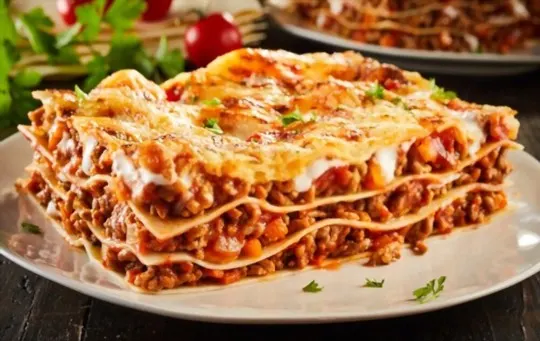Dig into a dish of pasticho and you’re treading on deliciously thin layers of tradition. Lasagna, on the other hand, feels like a cozy hug from an Italian grandma. Both have their tales, tangled in cheese and pasta.
We’ve all been there. Picking between the two can split families at dinner. Is it the Greek or Italian flag we’re saluting tonight?
Our nights spent battling over béchamel or ricotta seal the deal. We’re not experts. Nope. Just a bunch of food lovers, trying to clear the cheesy confusion.

What is Pasticho?

The traditional Venezuelan Pasticho dish is a rich and savory layered pasta casserole, similar to Italian lasagna.
- Pasticho originates from Venezuelan cuisine and shares similarities with the lasagna dish.
- It consists of layers of flat or curly tubular pasta sheets, beef or chicken-based meat sauce, cheese, and bechamel sauce.
- Pasticho also includes boiled eggs and strips of ham in between layers which differentiates it from lasagna.
- The dish is typically baked until golden brown on top to achieve a crispy texture.
- It is often served at special occasions such as Christmas, weddings, or family gatherings but can also be found in many restaurants worldwide.
- The recipe for pasticho can vary depending on personal preferences and regional traditions in Venezuela and other Latin American countries such as Colombia or Mexico.
Distinct from lasagna, the addition of boiled eggs and ham strips in pasticho distinguishes this dish’s flavor profile.
What is Lasagna?

Lasagna is a traditional Italian dish that features sheets of pasta layered with meat sauce, cheese, and sometimes vegetables.
It’s typically baked in the oven until golden brown and bubbly.
The meal has become quite popular in many parts of the world due to its delicious taste and simplicity in preparation.
Interestingly, while there is no official recipe for lasagna, there are several variations that exist depending on the region or household it is made in.
However, the common ingredients include mozzarella cheese, ricotta cheese, tomato sauce, ground beef or sausage.
It’s worth noting that lasagna differs from pasticho, which is a similar layered pasta dish commonly found in Latin America.
While both dishes are similar in concept and appearance, there are some key differences worth noting.
For instance, pasticho has bechamel sauce as a key ingredient unlike lasagna which does not use it regularly.
Differences Between Pasticho and Lasagna

Pasticho and Lasagna are two popular dishes made using pasta.
Although they may seem similar, there are some differences between them.
One notable difference is the type of pasta used; typically, lasagna is made with flat wide noodles, while pasticho is made using thick spaghetti or bucatini.
Additionally, the filling ingredients used in pasticho usually include ground beef or chicken, whereas lasagna commonly includes cheese and tomato sauce.
Finally, pasticho is typically topped with béchamel sauce and then baked in the oven until golden brown.
Another difference between these dishes is their origin.
Pasticho has its roots in Venezuela, where it is a staple dish at family gatherings and special occasions.
It is often served alongside other traditional Venezuelan foods such as empanadas and arepas.
On the other hand, lasagna has Italian origins and is widely considered a classic Italian dish that has gained popularity all over the world.
Origin and Cultural Background
The historical and cultural significance of Pasticho and Lasagna can be traced back to their respective origins.
Despite similarities, the two dishes have distinct differences that reflect the diverse cultural influences intertwined in each dish’s background.
The traditional methods of preparing and presenting these dishes signify a specific culture that has evolved over time.
Moreover, both Pasticho and Lasagna are widely popular across various countries due to their versatility in adapting local ingredients while still maintaining authenticity.
Each variation represents unique culinary preferences, giving consumers different options to experiment with flavors.
In terms of cultural background, Pasticho is rooted in Venezuelan culture and the central ingredients used are unique to this dish alone – such as plantains, capers, raisins or olives.
In contrast, Lasagna is an Italian food classic representing each region with their own recipe with slight variations in meat content, regional herbs like oregano or basil quantity and preference for ‘béchamel’ stlye white sauce over tomato based sauce.
Overall, pasticho vs lasagna is not a suitable comparison as both Traditional Recipes have their roots deeply settled into cultures which cannot be ignored.
Noodle Type and Layering Style
When it comes to creating the perfect layered pasta dish, noodle type and layering style play a crucial role.
The choice between flat, wide lasagna noodles or long, thin pasticho noodles can drastically alter the final product.
Additionally, the way the layers are arranged—such as alternating cheese, meat sauce and noodles in lasagna versus placing each ingredient separately in pasticho—can change the texture and presentation of the dish.
Both dishes also have regional variations that further differentiate them from one another.
Cheese Varieties Used
Both pasticho and lasagna are pasta-based dishes that entail a generous amount of cheese.
In general, the cheese varieties used in both dishes share fundamental similarities but differ in their type forms and quantity.
The most common cheese varieties used include ricotta, mozzarella, and parmesan cheese.
Whereas ricotta is generously included in pasticho, lasagna tends to use much less of it.
Likewise, Parmesan cheese is more widely used in lasagna than in pasticho due to its sharp taste that enhances the overall flavor of the dish.
Lastly, mozzarella also features prominently in both dishes but is baked differently based on the recipe.
Sauce and Seasoning Differences
The variations in seasoning and sauce make pasticho and lasagna distinct from each other.
Although both dishes share an origin, their ingredients differ significantly.
While lasagna features meaty tomato sauce with a healthy amount of Italian herbs like oregano and basil, pasticho’s uniqueness comes from its bechamel sauce and béchamel-infused pasta layers that are seasoned with nutmeg.
Pasticho is also greasier because of additional cheese toppings between its layers.
Similarities Between Pasticho and Lasagna

Both Pasticho and Lasagna share some similarities in their preparation.
The basic structure of layering sheets of dough alternated with proteins such as meat, vegetables, cheese, and sauces remains consistent across both dishes.
The layered dish is then cooked in an oven until it forms a crispy top layer that seals the flavors within.
Additionally, both Pasticho and Lasagna are common comfort foods that originated in Europe but gained popularity worldwide due to their delicious taste.
The fundamental approach to making these dishes is quite similar, but they differ slightly by geographical regions.
Both Pasticho and Lasagna have taken on unique regional variations through different ingredient choices, spices used in the sauce, or baking methods.
Some versions feature béchamel sauce while others opt for ricotta cheese as ingredients.
In Italy’s version of lasagna bolognese meat ragù is a staple whereas in Venezuela Pasticho has more emphasis on Chorizo or Chicken mixtures specific to Venezuelan cuisine.
Overall, despite slight regional differences between the two dishes Pasticho and Lasagna remain very similar when it comes to their fundamentals – alternating layers of pasta sheets with meaty fillings – while simultaneously being enduring staples of comfort food cuisine all over the world, thanks to their mouth-watering texture and rich flavor combinations.
Baking and Serving Methods
When it comes to preparing the beloved dishes’ pasticho and lasagna, there is a slight difference in their baking and serving methods.
While both require layers of pasta sheets, meat sauce, and cheese, pasticho prefers to use a chopped hard-boiled egg layer as well.
Additionally, lasagna is traditionally cut into square pieces for serving while pasticho is served in rectangular slices.
It’s essential to consider these differences to ensure the proper presentation of each dish on your table.
Popular Variations and Regional Differences
There are significant differences between pasticho and lasagna, stemming from their respective regional variations.
Their ingredients, layering, sauce, seasoning, and structure distinguish the two dishes.
Pasticho is a Venezuelan staple with layers of pasta, flavorful beef filling, white béchamel sauce, and shredded cheese on top.
Lasagna is an Italian classic with alternating layers of pasta sheets, tomato meat sauce, herbs like basil and oregano, creamy ricotta cheese filling followed by abundant mozzarella cheese toppings baked to perfection.
In terms of popular variations and regional differences in pasticho vs lasagna comparison; one must know that lasagna originated in northern Italy whereas pasticho is a South American specialty food.
Furthermore, people prefer different types of pasta sheets for each dish based on texture and thickness preferences.
The sauce also differs as people may add vegetables like carrots or celery to the tomato sauce used in lasagna whereas pasticho’s béchamel sauce is creamier without vegetables.
Some use a combination of both sauces in their recipes as well.
Additionally, seasonings like garlic or onion powder are used more frequently in lasagna while cumin or adobo seasoning dominates pasticho’s savory taste.
Lastly, some chefs add other ingredients such as mushrooms or green bell peppers to make their creations stand out from the usual recipe.
Such unique additions may vary according to personal taste preferences or be limited by availability depending upon a particular region’s culinary traditions surrounding each dish.
Conclusion
The dissimilarities between pasticho and lasagna are quite evident.
Despite having similar structures, they differ in the type of noodles used, spices in the sauce and selected toppings.
It is important to note that both cuisines originated from different regions and have their unique variations.
It’s also essential to note that both dishes bring distinct cultural significance to their respective cuisine history.
Pasticho originated from Latin America, while Lasagna hails from Italy.
As a result of this difference in culture, certain ingredients are more prominent than others.

Leave a comment